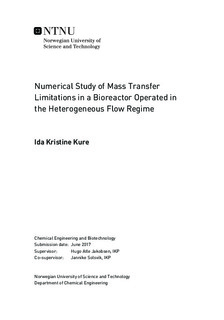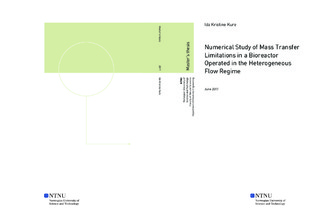| dc.description.abstract | With the increased focus on detaining a more environmental friendly industry, biological processes have been given more attention over the last years.
Such a biological process is single cell protein (SCP) production, which can use bacteria to utilize methane or methanol in the production of protein.
In SCP production, the methanotroph bacteria Methylococcus capsulatus, with its high protein content of approximately 70 %, is a well suited bacteria for the process.
With the bacteria being an aerobic bacteria, the mass transfer of oxygen to the cells is crucial.
Methanotroph bacteria utilize single-carbon compounds, typically methane, as their sole carbon and energy source.
It is therefore necessary with sufficient mass transfer of methane and oxygen in order to obtain a large bio-protein production.
Previous literature have stated that the SCP process is limited by mass transfer.
The objectives of this work were to model SCP process operated in a vertical three phase (slurry) bubble column reactor.
Emphasis was placed on evaluating the mass transfer limitations and the sensitivity to choice of correlation for the mass transfer coefficient.
Additionally, a model of a single bubble rising in a tube was derived.
The purpose was to obtain a model that can be used as a basis for choosing the best mass transfer coefficients for SCP production based on experimental data.
The reactor simulation results showed that with an average bubble diameter of 2 mm and with an initial biomass fraction of 3 wt%, the bio-protein production was limited by mass transfer.
Reducing the diameter with a factor of 5, resulted in the process being limited by the kinetics.
It was found that the mass transferred was affected by the choice of mass transfer coefficient.
In order to provide precise representations of the bio-protein production in SCP production, it should be prioritized to find an accurate correlation for the mass transfer coefficient.
Design of bio-reactors should have the aim of keeping the bubble size low in the reactor, as this will result in a higher mass transfer. | |

